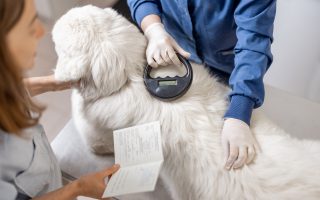Family friends: dog breeds from Brittany


The Dogs of Brittany
Brittany Spaniel
The Brittany Spaniel is one of the descendents of the Chien d’Oysel, a breed trained in the Middle Ages for netting game birds. He is the product of the initially accidental nineteenth-century crossbreeding of Brittany farm dogs—short, broad-backed, hardy, and used on woodcock—with English Setters, English Pointers, and English Springer Spaniels left in France during the off-season by British hunters in order to improve the new breed’s nose and speed. The Brittany Spaniel became increasingly popular. Mr. de Pontavic and Mr. de Combouz presented the breed in 1896 in Paris, and a breed club was founded in 1907 in Londéac. The first standard was adopted in 1908 and revised in 1938. The Brittany Spaniel is the second most popular dog in France, and the most popular French breed abroad. He is one of the most common pointers in the United States.
This hardy, enthusiastic, tireless dog with a fighting spirit can hunt on any type of terrain. “Maximum quality for minimum size” could be the motto of the breed club for this lightweight dog. With an excellent nose, he tracks rapidly, points firmly, and is a very good waterfowl retriever. A multi-purpose dog, he hunts game birds, preferring woodcock and snipe. Even-tempered, gentle, intelligent, and good-natured, he is a delightful pet. He needs gentle training, daily walks to let off steam. He requires brushing once or twice a week, as well as regular attention to the ears.
[mrb]
Brittany Fawn
The Great Brittany Fawn, which currently comes in two varieties—the Brittany Fawn Griffon and the Brittany Fawn Basset—is a very ancient breed. It was once used in famous large packs, such as that of Anne de Beaujeu, the daughter of King Louis XI. These spirited, strong-willed, yellowish- and reddish-fawn dogs standing 60 to 65 cm tall were the best wolf hunters around. The breed nearly went extinct in the late nineteenth century, when wolves became scarce. Crossbreeding produced a more lightweight hound, the Brittany Fawn Basset, for which the first standard was established in 1921. The Brittany Fawn Griffon—a medium-sized version of the Great Brittany Fawn—was declared extinct in 1928. But after World War II in 1949, a Medium-sized Brittany Fawn club was created. In 1981, the club saved the breed when it decided to include the Brittany Fawn Griffon (now the breed’s official name), standing 48 to 56 cm tall at the withers, and the Brittany Fawn Basset, standing 32 to 38 cm tall. The rapidly increasing popularity of these varieties, especially the basset, is encouraging.
The Great Brittany Fawn gave its modern-day descendents its hardiness, courage, vigor, spirit, speed, keen nose, strong will, and independent personality. The Brittany Fawn Basset, with his difficult character and stubbornness (crosses with the Vendée Griffon Basset have calmed him down), hunts alone, in pairs, in small groups, or in packs. He works in thickets, and rabbit is his specialty. When well-trained, he makes a good bloodhound. The Brittany Fawn Griffon is a very courageous, excellent pack leader with a glorious voice. He excels at wild boar and fox. Some also use him on hare and deer. Both varieties are calm and affectionate with their owner. These strong-willed hounds need firm training.
The Brittany Fawn Griffon, raised chiefly in packs, is usually kept in a kennel. The Brittany Fawn Basset can live with his owner inside the house or in an outdoor run. Both need space and lots of exercise, as well as regular brushing and attention to the ears.
Share to: Facebook Twitter LinkedIn Email
More in brittany, family, paris, pets, walking
By FrenchEntrée
Leave a reply
Your email address will not be published. Required fields are marked *



